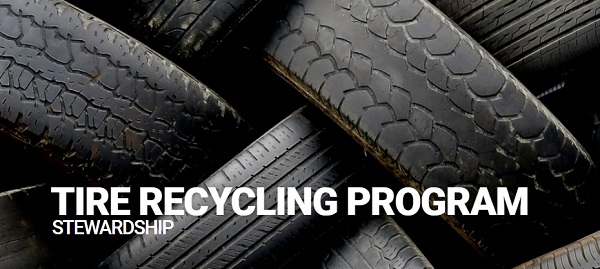Alberta
Alberta piloting test to supply industry with fuel derived from worn-out tires

Turning industrial waste into energy |
Alberta is launching a Tire-Derived Fuel pilot to test the effectiveness of turning old, worn-out tires into energy to power industrial facilities.
Alberta’s government is helping industry reduce emissions, save money and turn landfill waste into energy – all through technology.
Around the world, demand for industrial and manufacturing products is rising rapidly. Companies are looking for more ways to repurpose waste, decrease costs and increase operational efficiency while reducing emissions, but these improvements can be expensive and complex.
Alberta’s government and industry are stepping up and setting an example for the world, investing in two new programs to help more industrial and manufacturing companies reduce emissions, re-use waste and keep powering the world. In partnership with Lafarge Canada, the province will launch a program to expand the use of recycled spare tires and will invest $10 million in a second program to help industry save on their energy bills.
“We are investing in lower-emission fuels and facility upgrades to set our energy sector up for continued success. These new initiatives will keep our province at the forefront of technological advancement and ensure Alberta continues to lead the way to reduce emissions and turn waste into energy.”
New Tire-Derived Fuel Pilot Project
Alberta is launching a Tire-Derived Fuel pilot to test the effectiveness of turning old, worn-out tires into energy to power industrial facilities. Led by the Alberta Recycling Management Authority (ARMA), the pilot will turn up to 1.5 million used tires into up to 15,750 tonnes of chips that will become tire-derived fuel in the coming months.
Lafarge Canada’s new Low-Carbon Fuel Facility will participate in the pilot project. They have the equipment needed to burn waste-derived fuels, reducing their use of natural gas. Results from the pilot will be used to help determine whether tire-derived fuel should be permanently added to the province’s existing Tire Recycling Program.
New Strategic Energy Management for Industry Program
Alberta’s government is also investing $10 million from the industry-funded Technology Innovation and Emissions Reduction (TIER) fund to help launch the new Strategic Energy Management for Industry program, open for applications on Oct. 17.
Delivered through Emissions Reduction Alberta, the program will cover the cost of energy assessments and capital retrofits to save Alberta-based industrial and manufacturing facilities money on their energy bills. It will also provide energy management training, knowledge sharing and technical support.
Agriculture, forestry, fishing, hunting, mining, oil and gas, and cement companies will all be eligible for funding. Additional funding will also be provided by the Government of Canada and announced soon. More information will be shared on Emissions Reduction Alberta’s website.
New Low-Carbon Fuel Facility
Thanks in part to $10 million in TIER funding delivered through Emissions Reduction Alberta, Lafarge Canada has opened a cutting-edge Low-Carbon Fuel Facility that will replace up to 50 per cent of the natural gas it uses with low-carbon fuel from construction demolition waste. This will keep up to 120,000 tonnes of construction and demolition materials out of landfills and produce up to 30,000 fewer tonnes of emissions.
“The Tire-Derived Fuel Pilot program is another step in resource recovery. We appreciate the support from the Government of Alberta and industry partners like Lafarge Canada, enabling us to explore innovative recycling technologies to assess its viability. This pilot initiative not only addresses near-term tire stockpile reduction needs from our Tire Recycling Program, but also brings the potential to further boost economic opportunities across the province.”
“Improving the efficiency of industrial and manufacturing processes and facilities is the quickest, most cost-effective way to lower energy bills and stay competitive. But it takes knowledge, expertise, training and capital. With SEMI, Alberta companies will soon have even more opportunity to invest in energy and cost-saving technologies.”
“We’re pleased to see the Government of Alberta’s continued commitment to technology and innovation funding, which plays a crucial role in driving innovation and sustainability across all industries. Lafarge Canada has directly benefited from past support, helping us advance our low-carbon solutions. These funding opportunities empower us to accelerate our efforts to reduce emissions and contribute to a more sustainable future for Alberta.”
Quick facts
- Albertans have recycled more than 149.5 million tires and diverted hundreds of thousands of tonnes of tires from landfills since 1992 through ARMA’s existing Tire Recycling Program.
- Scrap tires are currently processed under ARMA’s Tire Recycling Program and turned into drainage material in municipal landfills, playground surfaces, sidewalk blocks, roofing tiles and landscaping mulch, but with markets for recycled tire products declining, alternative outlets are needed to avoid tire stockpiles.
- To date, Emissions Reduction Alberta has invested $960 million from the industrial carbon price toward more than 290 projects worth over $8.6 billion, estimated to reduce 40 million tonnes of emissions by 2030.
Related information
Alberta
Low oil prices could have big consequences for Alberta’s finances

From the Fraser Institute
By Tegan Hill
Amid the tariff war, the price of West Texas Intermediate oil—a common benchmark—recently dropped below US$60 per barrel. Given every $1 drop in oil prices is an estimated $750 million hit to provincial revenues, if oil prices remain low for long, there could be big implications for Alberta’s budget.
The Smith government already projects a $5.2 billion budget deficit in 2025/26 with continued deficits over the following two years. This year’s deficit is based on oil prices averaging US$68.00 per barrel. While the budget does include a $4 billion “contingency” for unforeseen events, given the economic and fiscal impact of Trump’s tariffs, it could quickly be eaten up.
Budget deficits come with costs for Albertans, who will already pay a projected $600 each in provincial government debt interest in 2025/26. That’s money that could have gone towards health care and education, or even tax relief.
Unfortunately, this is all part of the resource revenue rollercoaster that’s are all too familiar to Albertans.
Resource revenue (including oil and gas royalties) is inherently volatile. In the last 10 years alone, it has been as high as $25.2 billion in 2022/23 and as low as $2.8 billion in 2015/16. The provincial government typically enjoys budget surpluses—and increases government spending—when oil prices and resource revenue is relatively high, but is thrown into deficits when resource revenues inevitably fall.
Fortunately, the Smith government can mitigate this volatility.
The key is limiting the level of resource revenue included in the budget to a set stable amount. Any resource revenue above that stable amount is automatically saved in a rainy-day fund to be withdrawn to maintain that stable amount in the budget during years of relatively low resource revenue. The logic is simple: save during the good times so you can weather the storm during bad times.
Indeed, if the Smith government had created a rainy-day account in 2023, for example, it could have already built up a sizeable fund to help stabilize the budget when resource revenue declines. While the Smith government has deposited some money in the Heritage Fund in recent years, it has not created a dedicated rainy-day account or introduced a similar mechanism to help stabilize provincial finances.
Limiting the amount of resource revenue in the budget, particularly during times of relatively high resource revenue, also tempers demand for higher spending, which is only fiscally sustainable with permanently high resource revenues. In other words, if the government creates a rainy-day account, spending would become more closely align with stable ongoing levels of revenue.
And it’s not too late. To end the boom-bust cycle and finally help stabilize provincial finances, the Smith government should create a rainy-day account.
Alberta
Governments in Alberta should spur homebuilding amid population explosion

From the Fraser Institute
By Tegan Hill and Austin Thompson
In 2024, construction started on 47,827 housing units—the most since 48,336 units in 2007 when population growth was less than half of what it was in 2024.
Alberta has long been viewed as an oasis in Canada’s overheated housing market—a refuge for Canadians priced out of high-cost centres such as Vancouver and Toronto. But the oasis is starting to dry up. House prices and rents in the province have spiked by about one-third since the start of the pandemic. According to a recent Maru poll, more than 70 per cent of Calgarians and Edmontonians doubt they will ever be able to afford a home in their city. Which raises the question: how much longer can this go on?
Alberta’s housing affordability problem reflects a simple reality—not enough homes have been built to accommodate the province’s growing population. The result? More Albertans competing for the same homes and rental units, pushing prices higher.
Population growth has always been volatile in Alberta, but the recent surge, fuelled by record levels of immigration, is unprecedented. Alberta has set new population growth records every year since 2022, culminating in the largest-ever increase of 186,704 new residents in 2024—nearly 70 per cent more than the largest pre-pandemic increase in 2013.
Homebuilding has increased, but not enough to keep pace with the rise in population. In 2024, construction started on 47,827 housing units—the most since 48,336 units in 2007 when population growth was less than half of what it was in 2024.
Moreover, from 1972 to 2019, Alberta added 2.1 new residents (on average) for every housing unit started compared to 3.9 new residents for every housing unit started in 2024. Put differently, today nearly twice as many new residents are potentially competing for each new home compared to historical norms.
While Alberta attracts more Canadians from other provinces than any other province, federal immigration and residency policies drive Alberta’s population growth. So while the provincial government has little control over its population growth, provincial and municipal governments can affect the pace of homebuilding.
For example, recent provincial amendments to the city charters in Calgary and Edmonton have helped standardize building codes, which should minimize cost and complexity for builders who operate across different jurisdictions. Municipal zoning reforms in Calgary, Edmonton and Red Deer have made it easier to build higher-density housing, and Lethbridge and Medicine Hat may soon follow suit. These changes should make it easier and faster to build homes, helping Alberta maintain some of the least restrictive building rules and quickest approval timelines in Canada.
There is, however, room for improvement. Policymakers at both the provincial and municipal level should streamline rules for building, reduce regulatory uncertainty and development costs, and shorten timelines for permit approvals. Calgary, for instance, imposes fees on developers to fund a wide array of public infrastructure—including roads, sewers, libraries, even buses—while Edmonton currently only imposes fees to fund the construction of new firehalls.
It’s difficult to say how long Alberta’s housing affordability woes will endure, but the situation is unlikely to improve unless homebuilding increases, spurred by government policies that facilitate more development.
-

 2025 Federal Election2 days ago
2025 Federal Election2 days agoThe Anhui Convergence: Chinese United Front Network Surfaces in Australian and Canadian Elections
-

 2025 Federal Election2 days ago
2025 Federal Election2 days agoTrump Has Driven Canadians Crazy. This Is How Crazy.
-

 Automotive1 day ago
Automotive1 day agoCanadians’ Interest in Buying an EV Falls for Third Year in a Row
-

 2025 Federal Election2 days ago
2025 Federal Election2 days agoCarney Liberals pledge to follow ‘gender-based goals analysis’ in all government policy
-

 2025 Federal Election2 days ago
2025 Federal Election2 days agoPoilievre’s Conservatives promise to repeal policy allowing male criminals in female jails
-

 Entertainment2 days ago
Entertainment2 days agoPedro Pascal launches attack on J.K. Rowling over biological sex views
-

 conflict2 days ago
conflict2 days agoTrump tells Zelensky: Accept peace or risk ‘losing the whole country’
-

 2025 Federal Election1 day ago
2025 Federal Election1 day agoPoilievre Campaigning To Build A Canadian Economic Fortress








